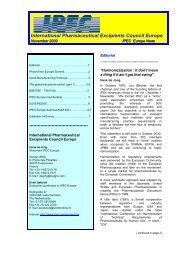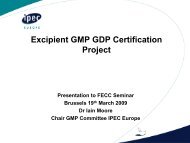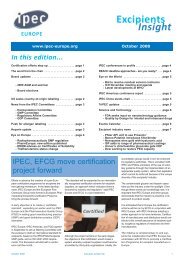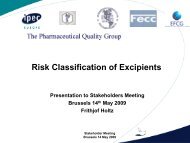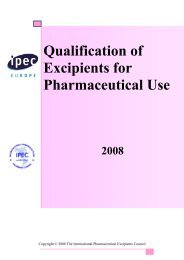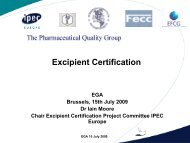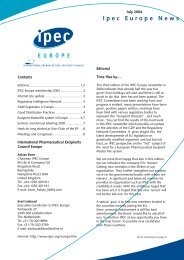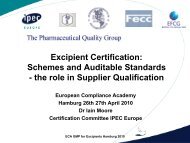The International Pharmaceutical Excipients Council - IPEC Europe
The International Pharmaceutical Excipients Council - IPEC Europe
The International Pharmaceutical Excipients Council - IPEC Europe
You also want an ePaper? Increase the reach of your titles
YUMPU automatically turns print PDFs into web optimized ePapers that Google loves.
<strong>The</strong><br />
<strong>International</strong><br />
<strong>Pharmaceutical</strong><br />
<strong>Excipients</strong><br />
<strong>Council</strong><br />
Certificate of Analysis Guide<br />
for <strong>Pharmaceutical</strong> <strong>Excipients</strong><br />
2013<br />
Copyright © 2013 <strong>The</strong> <strong>International</strong> <strong>Pharmaceutical</strong> <strong>Excipients</strong> <strong>Council</strong>
<strong>The</strong> <strong>IPEC</strong> Certificate of Analysis Guide for <strong>Pharmaceutical</strong> <strong>Excipients</strong><br />
This document represents voluntary guidance for the pharmaceutical excipient<br />
industry and the contents should not be interpreted as regulatory requirements.<br />
Alternative approaches to those described in this guide may be implemented.<br />
FOREWORD<br />
<strong>International</strong> <strong>Pharmaceutical</strong> <strong>Excipients</strong> <strong>Council</strong> (<strong>IPEC</strong>) is an international industry<br />
association formed in 1991 by manufacturers, distributors and end-users of excipients. At the<br />
time of writing there are regional pharmaceutical excipient industry associations including<br />
the Americas, <strong>Europe</strong>, China, and Japan. <strong>IPEC</strong>’s objective is to contribute to the development<br />
and harmonization of international excipient standards, the introduction of useful new<br />
excipients to the marketplace, and the development of best practice and guidance concerning<br />
excipients.<br />
<strong>IPEC</strong> has three major stakeholder groups;<br />
1. Excipient manufacturers and distributors, who are considered suppliers in this<br />
document,<br />
2. <strong>Pharmaceutical</strong> manufacturers, who are called users, and<br />
3. Regulatory authorities who regulate medicines.<br />
Suppliers<br />
<strong>IPEC</strong><br />
Users<br />
Regulatory<br />
Authorities<br />
This document offers best practice and guidance on the content of an excipient Certificate of<br />
Analysis (COA). It is important that the reader confirm this is the latest version of the guide<br />
as found on ipecamericas.org or ipec-europe.org.<br />
Copyright © 2013 <strong>The</strong> <strong>International</strong> <strong>Pharmaceutical</strong> <strong>Excipients</strong> <strong>Council</strong><br />
i
TABLE OF CONTENTS<br />
FOREWORD<br />
i<br />
ACKNOWLEDGEMENTS<br />
iii<br />
1 INTRODUCTION 1<br />
1.1 Purpose 1<br />
1.2 Scope 1<br />
1.3 Principles Adopted 1<br />
2 GENERAL GUIDANCE 1<br />
3 DESIGN AND REQUIRED ELEMENTS OF A CERTIFICATE OF ANALYSIS 2<br />
4 COA CONTENT 3<br />
4.1 Identifying Information 3<br />
4.2 Body 3<br />
4.3 Certification and Compliance Statements 4<br />
4.4 Authorization 4<br />
5 REQUIREMENTS FOR COMPENDIAL DESIGNATION 4<br />
6 ESTABLISHING DATES ON A CERTIFICATE OF ANALYSIS 5<br />
6.1 General Guidance 5<br />
6.2 Date of Manufacture 5<br />
6.3 Expiration Date and Recommended Retest Date 5<br />
6.4 Date Retested 6<br />
6.5 Additional Dates 6<br />
7 REPORTING OF DATA 6<br />
7.1 General Guidance 6<br />
7.2 Data versus Conformance 7<br />
7.3 Alternatives to Finished Excipient Testing 7<br />
7.3.1 Documentation 8<br />
7.3.2 Examples 8<br />
8 USE OF ELECTRONICALLY GENERATED CERTIFICATE OF ANALYSIS 8<br />
9 DISTRIBUTOR INFORMATION 9<br />
APPENDIX 1: REFERENCES 10<br />
APPENDIX 2: ALTERNATIVES TO FINISHED EXCIPIENT TESTING-<br />
EXAMPLES 12<br />
APPENDIX 3: MODEL COA 13<br />
Copyright © 2013 <strong>The</strong> <strong>International</strong> <strong>Pharmaceutical</strong> <strong>Excipients</strong> <strong>Council</strong><br />
ii
ACKNOWLEDGEMENTS<br />
This guide was developed by representatives of many of the member companies of the<br />
<strong>International</strong> <strong>Pharmaceutical</strong> <strong>Excipients</strong> <strong>Council</strong>, an industry association whose members<br />
consist of excipient manufacturers, distributors, and users. <strong>The</strong> company representatives who<br />
worked on this Guide are listed below:<br />
<strong>IPEC</strong>-Americas<br />
William Busch - <strong>The</strong> Dow Chemical Company<br />
Juanita Garofalo - Avantor Performance Materials, Inc.<br />
David Klug, - Sanofi U.S.<br />
Philip Merrell, Ph.D. – Jost Chemical<br />
R. Christian Moreton, Ph.D. – FinnBrit Consulting<br />
Irwin Silverstein, Ph.D. –<strong>International</strong> <strong>Pharmaceutical</strong> <strong>Excipients</strong> Auditing<br />
Robert Sulouff - Ashland, Inc.<br />
Ann Van Meter – Dow Wolff Cellulosics<br />
Priscilla Zawislak – Ashland, Inc.<br />
<strong>IPEC</strong> <strong>Europe</strong><br />
Christian Becker - BASF SE<br />
Kate Denton - Novozymes Biopharma<br />
Erhard Luehrs - Merck KGaA<br />
Gianluca Minestrini - Hoffman LaRoche<br />
Copyright © 2013 <strong>The</strong> <strong>International</strong> <strong>Pharmaceutical</strong> <strong>Excipients</strong> <strong>Council</strong><br />
iii
1 INTRODUCTION<br />
1.1 Purpose<br />
This document is meant to serve as a guide for the preparation and appropriate use of a<br />
Certificate of Analysis (COA) for pharmaceutical excipients. [Note that the first time a<br />
term is used, it is denoted in bold typeface and is defined in the <strong>IPEC</strong> Glossary 1 .] <strong>The</strong><br />
goal is to standardize the content and suggest a format for COAs for excipients, and to<br />
clearly define the roles and responsibilities for the excipient manufacturer and<br />
distributor. <strong>The</strong> detailed definitions and discussions are intended to establish a uniform<br />
approach. By providing this foundation for mutual understanding, the COA will serve as<br />
an important element of the overall supply chain controls needed to provide the user with<br />
assurance of excipient conformance to specification and its suitability for use in<br />
pharmaceuticals.<br />
1.2 Scope<br />
This guide is applicable to excipients used in the manufacture of pharmaceutical<br />
products.<br />
1.3 Principles Adopted<br />
This is an international guide. As such it cannot specify all national legal requirements or<br />
cover in detail the particular characteristics of every excipient.<br />
When considering the use of this guide, manufacturers and distributors should consider<br />
how it may apply to that specific organization’s product. <strong>The</strong> diversity of excipients<br />
means that some principles of the guide may not be applicable to certain products and<br />
processes. <strong>The</strong> terminology “should” and “it is recommended” do not necessarily mean<br />
“must” and common sense should be used in the application of this guide.<br />
2 GENERAL GUIDANCE<br />
<strong>The</strong> COA is a legal document that certifies the quality of the excipient and demonstrates that<br />
the batch conforms to the defined specifications, has been manufactured under excipient<br />
GMP, and is suitable for use in pharmaceuticals. It should not be used in lieu of appropriate<br />
qualification of the supplier. 2<br />
A COA for excipients should be prepared and issued by the company responsible for the<br />
material, following the general guidelines discussed below. It is expected that a complete and<br />
accurate COA is provided to the user for each batch and/or delivery of excipient. When<br />
analysis is performed by a distributor, the distributor should issue a COA to the user for any<br />
analysis that was performed by or on behalf of the distributor. In such cases, industry best<br />
practice is for the distributor to provide the user with the original manufacturer’s COA and<br />
the distributor’s COA.<br />
Identification testing by the excipient manufacturer is not a regulatory requirement. <strong>The</strong><br />
1 <strong>IPEC</strong> Glossary www.ipecamericas.org/glossary<br />
2 <strong>IPEC</strong> Qualification of <strong>Excipients</strong> for Use in <strong>Pharmaceutical</strong>s, 2008<br />
Copyright© 2013 <strong>IPEC</strong> 1
excipient manufacturer is not required to perform identity tests if they have process controls<br />
in place that together with testing assure the identity of the excipient.<br />
3 DESIGN AND REQUIRED ELEMENTS OF A CERTIFICATE OF ANALYSIS<br />
<strong>The</strong> elements of a COA listed below are included in the COA Content section of the guide<br />
(see section 4). <strong>The</strong> excipient supplier (manufacturer or distributor) may organize the<br />
elements on the COA at their discretion; however, the sections have been designed to present<br />
the required and optional information in a logical manner.<br />
<strong>The</strong> original manufacturer and manufacturing site should be identified if different from the<br />
supplier and supplier location. <strong>The</strong> intent is to enable the user to assure that a change in<br />
manufacturing location has not occurred without their knowledge 3 . It is essential that the<br />
manufacturer be known to the user. To protect confidentiality through the supply chain, the<br />
use of codes for manufacturers and manufacturing sites on the COA is acceptable as long as<br />
the user can link the code to the manufacturer and site of manufacture.<br />
<strong>The</strong> identity of the excipient should be definitively established by stating compendial and<br />
trade name, the grade of the material, and applicable compendial designations.<br />
A batch number or other means of uniquely identifying the material quantity covered by the<br />
COA and information relating specifically to it are typically included in a Body Section.<br />
Unique identification of the excipient links the COA to the relevant specification 4 and is<br />
traceable to a specified batch. <strong>The</strong> date of manufacture and if applicable, the expiration<br />
date, recommended retest date, or other relevant statement regarding the stability of the<br />
excipient is typically included in this section (a detailed discussion of dates on the COA is<br />
contained in Section 6). User required information could also be included here.<br />
<strong>The</strong> actual test results applicable to the quantity of material covered by the COA are included<br />
in an Analysis Section. <strong>The</strong> acceptance criteria and test results are preferably included for<br />
each characteristic listed. Test method designation and acceptance criteria may be<br />
communicated to the customer by reference to other controlled documents, e.g. sales<br />
specifications.<br />
Reporting of actual data and observations is recommended rather than non-specific “passes”<br />
or “conforms” statements unless the test is qualitative, or this is the acceptance criteria as<br />
listed in a compendium or other specification.<br />
If the reported results are not derived from sampling the finished excipient batch, it should be<br />
noted on the analysis section of the COA (See Section 7.2 for a detailed discussion of such<br />
considerations). In such cases alternative options for the origin of test results other than<br />
3 Note that a Confidentiality Agreement or Quality Agreement may be required.<br />
4 Best practice is to include a reference to the User’s current specification, i.e., specification number and version or<br />
issue date on the COA.<br />
Copyright© 2013 <strong>IPEC</strong> 2
Quality Control laboratory testing include for example 5 :<br />
• In-process testing, or<br />
• Continuous monitoring of an attribute or variable and application of appropriate<br />
Statistical Process Control (SPC) methods.<br />
It may be acceptable not to perform a test when the test attribute cannot be present or cannot<br />
fail to meet acceptance criteria, e.g. limited by upstream controls that involve measurement<br />
for an impurity to assure it does not enter or form in the process. Not performing a specified<br />
test should be supported by a suitable documented rationale based on a documented risk<br />
assessment.<br />
<strong>The</strong> Certification and Compliance Statements Section (4.3) is used to list various statements<br />
that may be required depending on the excipient and agreed user requirements. Any<br />
declaration by the supplier as to compliance with compendial and/or other regulatory<br />
requirements is typically included in this section.<br />
<strong>The</strong> basis for COA approval should appear on the COA (Section 8).<br />
4 COA CONTENT<br />
<strong>The</strong> following information should appear on the COA or by reference. It is important that all<br />
pages of the COA are numbered and include the total number of pages for document control<br />
and to assure the customer that all pages of the COA are present. See Appendix 3 for a model<br />
COA.<br />
4.1 Identifying Information<br />
4.2 Body<br />
• Title “Certificate of Analysis”<br />
• Identity and address of original manufacturing site: name or other suitable<br />
identifier that is unique to the manufacturer and site (e.g. code)<br />
• Responsible organization that issues the COA, address, and contact information<br />
(if different from original manufacturer),<br />
• Name (compendial or chemical) and Compendial Designation, as applicable<br />
• Grade<br />
• Trade Name<br />
• Batch Number<br />
• Date of Manufacture<br />
• Unique identifier to the excipient specification<br />
• Expiration or Retest Date (as applicable) or Stability Statement<br />
5 Brian Carlin, Dale Carter, Moira Griffiths, Gregory Larner, Kevin Moore, Barry Rothman, David Schoneker,<br />
Catherine Sheehan, Rajendra Uppoor, Phyllis Walsh, and Robert Wiens, Joint Position Paper on <strong>Pharmaceutical</strong><br />
Excipient Testing and Control Strategies, Pharm. Technol. 31 (9) 2007 pages 1-19<br />
Copyright© 2013 <strong>IPEC</strong> 3
• Specification<br />
o Test Name<br />
o Reference to the Test Method<br />
o Acceptance Criteria<br />
• Analysis<br />
o Test Results based on finished excipient sample, or<br />
o Alternative test results, as appropriate (Section 7.3)<br />
o Date Retested (if appropriate)<br />
4.3 Certification and Compliance Statements (may be provided in other documents, e.g.<br />
Excipient Information Package 6 )<br />
• Standard of GMP applied (e.g., <strong>IPEC</strong>-PQG Excipient, ICH Q7)<br />
• Additional compliance statements and applicable references to standards<br />
• Potential to meet additional Compendial Standards<br />
• Content listing and grade of ingredients (if a mixture)<br />
• Customer specified information<br />
4.4 Authorization<br />
• Identity of authorized individual for approval or electronic signature statement<br />
• Date of approval or suitable alternative<br />
• Page Number (i.e., 1 of X pages)<br />
5 REQUIREMENTS FOR COMPENDIAL DESIGNATION<br />
For a supplier to claim a compendial grade on the COA for an excipient, there are two<br />
requirements to be met 7 . <strong>The</strong> first requirement is that the excipient is manufactured according<br />
to recognized principles of good manufacturing practices. <strong>The</strong> second requirement is that the<br />
excipient meets all of the acceptance criteria contained in the appropriate compendial<br />
monograph. <strong>The</strong>se expectations remain in effect until its expiration or recommended retest<br />
date when stored according to manufacturers' recommendations in the manufacturer’s<br />
original unopened container.<br />
Every compendial article shall be so constituted that when examined in accordance with<br />
these assay and test procedures, it meets all the requirements in the monograph defining it, as<br />
well as meeting any provisions of the General Notices, General Chapters or Rules, as<br />
applicable. “However, it is not to be inferred that application of every analytical procedure in<br />
the monograph to samples from every production batch is necessarily a prerequisite for<br />
assuring compliance with compendial standards before the batch is released for<br />
distribution.” 8 Data derived from in-process testing or continuous monitoring of an attribute<br />
6 <strong>International</strong> <strong>Pharmaceutical</strong> <strong>Excipients</strong> <strong>Council</strong> of the Americas Standardized Excipient Information Protocol<br />
User Guide 2005<br />
7 Joint <strong>IPEC</strong>-PQG Good Manufacturing Practice Guide for <strong>Pharmaceutical</strong> <strong>Excipients</strong>, 2006 and General Notices to<br />
the USP and Ph.Eur.<br />
8 WHO Technical Report Series, No. 902 and 908<br />
Copyright© 2013 <strong>IPEC</strong> 4
with statistical process control may be used. With appropriate scientific justification,<br />
analytical methods that are equivalent or better (i.e. more accurate, more precise, etc.) to that<br />
which appears in the monograph may be substituted by the supplier when judging<br />
compliance of the batch with the compendial standards (See Section 7).<br />
6 ESTABLISHING DATES ON A CERTIFICATE OF ANALYSIS<br />
6.1 General Guidance<br />
In reporting dates on COAs for excipients, it is important that a clear and unambiguous<br />
format be used to prevent possible misinterpretation. To accomplish this, it is<br />
recommended that an alphabetic designation be used for the month (it may be<br />
abbreviated), rather than a numerical representation. It is also recommended that the<br />
year include all 4-digits (i.e.; Jan. 1, 2010 or 1 Jan. 2010, etc.).<br />
6.2 Date of Manufacture<br />
<strong>The</strong> Date of Manufacture should be clearly defined by the original manufacturer and<br />
consistently applied for the particular excipient and process based on established policies<br />
and procedures.<br />
It is important to note that while re-packaging operations are to conform to GMP<br />
requirements, repackaging alone is not considered a processing step that can be used in<br />
determining the Date of Manufacture. To provide traceability for a specific excipient<br />
batch, other dates may be required in addition to the Date of Manufacture, to reflect<br />
additional steps, such as re-packaging.<br />
6.3 Expiration Date and Recommended Retest Date<br />
<strong>The</strong> stability of excipients may be an important factor in the stability of the finished<br />
pharmaceutical dosage forms that contain them. <strong>The</strong>refore, it is important that the COA<br />
indicates stability of the excipient either by reporting the Expiration Date and/or the<br />
recommended Retest Date. This provides users with key information concerning the<br />
usability of the excipient in the period between the date of manufacture and the use of the<br />
excipient by the user.<br />
Appropriate Expiration and/or Recommended Retest Dates for excipients should be<br />
established from the results of a documented stability-testing program, or from<br />
documented historical data 9 . Where the excipient is re-packed, the effect of this operation<br />
and the new packaging materials on the expiry or retest date should be evaluated to<br />
determine if such dates need to be changed.<br />
<strong>The</strong> expiration date of an excipient cannot be extended. <strong>The</strong> Retest Date for an excipient<br />
is the date indicated by the supplier after which the excipient should be re-evaluated to<br />
ensure continued compliance with appropriate specifications. An excipient retest date<br />
9 <strong>IPEC</strong> Excipient Stability Program Guide 2009<br />
Copyright© 2013 <strong>IPEC</strong> 5
may be extended based upon appropriate testing. <strong>The</strong> re-evaluation of the excipient may<br />
include physical inspection and/or appropriate chemical, physical, or microbiological<br />
testing.<br />
It is acceptable to report both an Expiration Date and a Recommended Retest Date on the<br />
COA for excipients if applicable. Expiration and Recommended Retest Dates should not<br />
be reported by a supplier without sufficient stability data or product history to support the<br />
assigned dates.<br />
If stability data in accordance with the <strong>IPEC</strong> Stability Guide is not available for an<br />
excipient, then an appropriate statement should be included on or with the COA to<br />
indicate what is known about the stability of the material, and/or whether stability studies<br />
are in progress.<br />
6.4 Date Retested<br />
If retesting is performed by an excipient supplier (as noted in 6.3) and the results are used<br />
by the supplier to extend the length of time that the material may be used, then the Date<br />
Retested should also be reported preferably on the COA, but alternative communication<br />
means are acceptable. <strong>The</strong> specific tests that were subject to retesting should be clearly<br />
identified and the results obtained upon retesting should be reported. After retesting, a<br />
new Recommended Retest Date should be reported on the COA.<br />
6.5 Additional Dates<br />
Other dates may appear on a COA, if desired by the excipient supplier or requested by<br />
the user. Examples include the release date, shipping date, date of testing, and date the<br />
COA was printed or approved. Any additional dates that appear on a COA for excipients<br />
should include a clear indication of what the date represents.<br />
7 REPORTING OF DATA<br />
7.1 General Guidance<br />
Many excipients are listed in pharmacopeias and other standard reference works. <strong>The</strong><br />
excipient specifications are set by the supplier to include all necessary parameters. Some<br />
pharmacopeias do not require that analysis of all specification parameters be made on<br />
each batch 10 prior to release. However, sufficient analysis and evidence of process<br />
stability should exist to assure that the batch meets all specifications before it is released<br />
(see 7.3). Periodic testing of all parameters should be performed to confirm continuing<br />
compliance. All the parameters should be checked at an appropriate frequency.<br />
<strong>The</strong> USP-NF and Ph.Eur. allow the use of alternate methods of testing provided the<br />
alternate methods have been shown to be as effective or better than the monograph<br />
methods.<br />
10 See current USP-NF, General Notices; Ph.Eur., General Notices; 21 CFR 211.84 (d) (2)<br />
Copyright© 2013 <strong>IPEC</strong> 6
For excipients that are not included in any pharmacopeia, specifications should be set by<br />
the supplier to ensure that the quality of the material is maintained on a continuing basis,<br />
and reflects both the inherent properties of the excipient and its manufacturing process.<br />
Specification methods should be demonstrated to provide accurate, reproducible and<br />
repeatable results for the characteristic being tested.<br />
7.2 Data versus Conformance<br />
Finished excipient tests are often performed on bulk excipient after all manufacturing<br />
processes are complete, but prior to packaging. “Where an in-process or bulk excipient<br />
test result is traceable to the finished excipient material, such a test result can be reported<br />
on the COA.” 5 When a compendial or specification test is not performed on the<br />
excipient batch, in-process, bulk or packaged, this should be indicated on the COA.<br />
Typical statements in lieu of data are “conforms”, “if tested will meet compendial<br />
requirements”, use of a footnote to indicate the last measurement or other suitable<br />
practice.<br />
Measurements reported on a COA can be derived from:<br />
1. Testing a representative sample from the finished excipient batch,<br />
2. In-process testing of a representative sample where the attribute remains<br />
unaffected by further routine processing,<br />
3. Continuous monitoring of an attribute in combination with statistical process<br />
controls.<br />
Where 2 or 3 apply, the technique for how the test result was obtained should be<br />
described.<br />
Some attributes e.g., BSE/TSE, Residual Solvent , may not be reported on the<br />
COA, but may be provided separately, e.g., in an Excipient Information Package.<br />
7.3 Alternatives to Excipient Testing<br />
For excipients used in drugs sold in the U.S., if an excipient attribute “has required<br />
criteria, there must be some measurement or test of the material in each lot to ensure that<br />
the criteria are met. This may be a measurement from a surrogate test, from in-process<br />
control data, or from testing or measurement of the finished material in each batch.<br />
Conversely, FDA representatives believe that an approach, which allows for skip testing<br />
based on a satisfactory product quality history alone, is not acceptable from a CGMP<br />
standpoint because such an approach does not adequately verify that each lot meets all<br />
of its specifications.” 5<br />
It is noted that ICH Q6A allows for periodic/skip lot testing of the drug product and drug<br />
substance.<br />
Results from in-process testing can also be used to replace testing on the finished<br />
excipient. “To ensure that a lot of excipient material complies with its required<br />
Copyright© 2013 <strong>IPEC</strong> 7
properties, it is acceptable to rely on tests or measurements conducted on samples of<br />
material taken at an in-process stage of production, provided that the in-process material<br />
will not be affected by subsequent processing or holding with respect to the attributes<br />
being verified. <strong>The</strong>re should be justification that test results or measurements, or product<br />
performance characteristics, do not change from the in-process stage to the finished<br />
product.” 8<br />
7.3.1 Documentation<br />
<strong>The</strong> supplier of an excipient should develop and maintain documentation which<br />
outlines the process control systems and validation data which justify the use of<br />
alternatives to finished excipient testing. This documentation should also include<br />
procedures for handling the impact of significant changes on the testing<br />
program 11 .<br />
7.3.2 Examples<br />
See Appendix 2<br />
8 USE OF ELECTRONICALLY GENERATED CERTIFICATES OF ANALYSIS<br />
Certificates of Analysis issued from computer systems without a handwritten signature are<br />
common place and are acceptable provided the appropriate controls are in-place. <strong>The</strong><br />
following considerations should be met:<br />
• Access to the computer system for COA management, entering and editing of data<br />
should be limited to authorized personnel. Authentication by username and password<br />
as well as the change of each individual password at an appropriate frequency should<br />
be required. Confirmation of the integrity and accuracy of the information stored in<br />
the system and transferred to the printed record should be completed during<br />
implementation and then periodically checked thereafter.<br />
• Data entered into a computer system from which information is extracted for a COA<br />
and changes made thereafter should be accompanied by time- and date-stamped audit<br />
trails.<br />
With these criteria met, the issuance of electronically generated COAs is acceptable provided<br />
the COA includes contact information.<br />
9 DISTRIBUTOR INFORMATION<br />
Distributors provide excipients and associated services such as:<br />
• Provide excipient in the manufacturers unopened original package (pass through)<br />
• Repackage from bulk quantities<br />
• Purchase of excipients for re-packaging under a different label.<br />
<strong>The</strong> nature of the associated services may impact the COA provided as discussed in the<br />
<strong>IPEC</strong> Good Distribution Practices Guide for <strong>Pharmaceutical</strong> <strong>Excipients</strong> section 6.3.<br />
11 <strong>IPEC</strong>-Americas Significant Change Guide for Bulk <strong>Pharmaceutical</strong> <strong>Excipients</strong> (2009).<br />
Copyright© 2013 <strong>IPEC</strong> 8
It is expected that the distributor will have the appropriate level of good manufacturing<br />
practice in place (for example the Joint <strong>IPEC</strong>-PQG Good Manufacturing Practices Guide for<br />
<strong>Pharmaceutical</strong> <strong>Excipients</strong> or the <strong>IPEC</strong> Good Distribution Practices Guide for<br />
<strong>Pharmaceutical</strong> <strong>Excipients</strong>).<br />
Copyright© 2013 <strong>IPEC</strong> 9
APPENDIX 1<br />
REFERENCES<br />
<strong>The</strong> Joint <strong>IPEC</strong> – PQG Good Manufacturing Practices Guide for <strong>Pharmaceutical</strong> <strong>Excipients</strong>,<br />
2006<br />
<strong>IPEC</strong> Qualification of <strong>Excipients</strong> for Use in <strong>Pharmaceutical</strong>s, 2008<br />
<strong>IPEC</strong> Good Distribution Practices Guide for <strong>Pharmaceutical</strong> <strong>Excipients</strong>, 2006<br />
<strong>International</strong> <strong>Pharmaceutical</strong> <strong>Excipients</strong> <strong>Council</strong> of the Americas Standardized Excipient<br />
Information Protocol User Guide 2005<br />
<strong>International</strong> <strong>Pharmaceutical</strong> <strong>Excipients</strong> <strong>Council</strong> of the Americas Significant Change Guide for<br />
Bulk <strong>Pharmaceutical</strong> <strong>Excipients</strong>, 2009<br />
Glossary of Official Definitions for <strong>Excipients</strong>, www.ipecamericas.org/glossary<br />
21 CFR Part 211 Current Good Manufacturing Practice for Finished <strong>Pharmaceutical</strong>s<br />
WHO <strong>International</strong> Drug GMPs, Interpharm Press, Inc., June 1993<br />
WHO Expert Committee on Specifications for <strong>Pharmaceutical</strong> Preparations. Thirty-sixth report.<br />
Geneva, World Health Organization, 2002, Annex 10 (WHO Technical Report Series, No. 902)<br />
WHO Expert Committee on Specifications for <strong>Pharmaceutical</strong> Preparations. Thirty-seventh<br />
report. Geneva, World Health Organization, 2003, p 87 (WHO Technical Report Series, No.<br />
908)<br />
Volume 2: How to Perform Continuous Sampling (CSP) and Volume 4: How to Perform Skip-<br />
Lot and Chain Sampling by Kenneth Stephens, ASQ, 1979 and 1982<br />
United States Pharmacopeia/ National Formulary (USP/NF)<br />
<strong>Europe</strong>an Pharmacopoeia (Ph.Eur.)<br />
Japanese Pharmacopoeia (JP)<br />
Japanese <strong>Pharmaceutical</strong> <strong>Excipients</strong> (JPE)<br />
Glossary and Tables for Statistical Quality Control, 3rd Edition, ASQC Statistics Division,<br />
ASQC Quality Press, Milwaukee, WI<br />
ANSI/ASQC A1-1978, Definitions, Symbols, Formulas and Tables for Control Charts, ASQC,<br />
(1978), Milwaukee, WI<br />
Copyright© 2013 <strong>IPEC</strong> 10
APPENDIX 1<br />
Quality Assurance for the Chemical and Process Industries: A Manual of Good Practices,<br />
Chemical Interest Committee, Chemical and Process Industries Division, American Society for<br />
Quality Control, (1987), ASQC Quality Press, Milwaukee, WI<br />
21 CFR Part 11 Electronic Records; Electronic Signatures; Final Rule<br />
Copyright© 2013 <strong>IPEC</strong> 11
APPENDIX 2<br />
Alternatives to Excipient Testing-Examples<br />
<strong>The</strong> following are examples of situations where alternatives to finished excipient testing<br />
might be justified. <strong>The</strong>se are not the only situations where a sound technical basis can be<br />
demonstrated, neither are they examples of situations where alternatives to finished excipient<br />
testing will always be appropriate.<br />
• An impurity, by-product or unreacted raw material could not be present in the product<br />
because the raw materials and chemical reactions used could not contain or generate<br />
it above the specified limits.<br />
• <strong>The</strong> Process Capability Index (Cp) for the relevant parameter is high and thus<br />
indicates a stable process. Statistical analysis of the reduced frequency data should<br />
show that the property remains stable and within specifications. A process is<br />
considered stable when the output of the process, regardless of the nature of the<br />
processing (batch or continuous), can be demonstrated, by appropriate means, to<br />
show a level of variability which consistently meets all aspects of the stated<br />
specification, (both pharmacopeia and user specific) and is thus acceptable for its<br />
intended use. For continuous processing, it is also important to demonstrate that the<br />
material has been produced under conditions where the process has achieved a form<br />
of ‘steady state’, i.e. minimal operator intervention and the in-process parameters<br />
have been stabilized.<br />
• For a continuous process, the in-process analyses show that the property which is<br />
determined at reduced frequency is stable and within specification. Repeating the test<br />
on each batch would be redundant<br />
• An analysis of a parameter that is determined on every batch in process has been<br />
shown to provide assurance that the final test requirement can be met. Such data can<br />
be used to support testing the finished excipient at reduced frequency.<br />
Copyright© 2013 <strong>IPEC</strong> 12
APPENDIX 3<br />
<strong>The</strong> following example COA is provided to illustrate the principles discussed in the guide<br />
and is not meant to be prescriptive.<br />
Supplier Company Name<br />
Supplier Company Address<br />
Certificate of Analysis<br />
[sample tests, limits and statements are for demonstration purposes]<br />
Manufacturing Location Phone: xxx-xxx-xxxx<br />
Name of Manufacturer (if different from Supplier) Fax: xxx-xxx-xxxx<br />
Manufacturing Site Address<br />
Product: Trade Name and Descriptor or Common Name<br />
Grade: Grade Designation<br />
Customer Code: xxxxxx (if applicable)<br />
Batch Number: xxxxxx Date of Manufacture: dd/mmm/yyyy<br />
Recommended Retest Date: <br />
Compendial Name and listing USP-NF, Ph.Eur., JP, or JPE<br />
(List multiple names and designations if nomenclature is different in each compendium)<br />
TEST RESULTS (sample tests & limits for demonstration purposes)<br />
Test Test Method Specification Results<br />
Appearance Visual Examination White Granular Powder Complies<br />
Foreign Matter Visual Examination Free from visible contamination Complies<br />
Identification-JPE Tests A-C Pass Complies<br />
Clarity and Color JPE Clear and colorless Complies<br />
pH (x% solution) USP 5.0 – 7.0 #.#<br />
Residue on Ignition JPE NMT 1.0% (450 –550C) #.# %<br />
Viscosity (x% solution) Ph.Eur. 4.0 – 7.0 mPa-s (@20c) #.# mPa-s<br />
Water Insoluble Sub. USP NMT 0.1% #.# %<br />
Loss on Drying (110C) USP NMT 5.0% #.# %<br />
Loss on Drying (105C) JPE NMT 6.0% #.# %<br />
Particle Size Supplier Method # 99.5%
APPENDIX 3<br />
<strong>The</strong> following example COA is provided to illustrate the principles discussed in the guide<br />
and is not meant to be prescriptive.<br />
Supplier Company Name<br />
Supplier Company Address<br />
Product: Trade Name and Descriptor or Common Name<br />
Grade: Grade Designation<br />
Batch Number:<br />
xxxxxxx<br />
Certification and Compliance Statements<br />
GMP compliance: This batch of has been manufactured using excipient Good<br />
Manufacturing Practices.<br />
Compendial Standards: This batch of complies with all of the current requirements<br />
listed in the United States Pharmacopeia (USP), the <strong>Europe</strong>an Pharmacopeia (Ph.Eur.) and the Japanese<br />
<strong>Pharmaceutical</strong> <strong>Excipients</strong> (JPE).<br />
Other Certification Statements: Any other type of certification, e.g., Residual Solvents, Genetically<br />
Modified Organism (GMO) derived, or customer specific information should be listed here. <strong>The</strong>se may<br />
vary depending on regional regulatory requirements, specific GMP issues and customer desired<br />
information based on their use of the excipient.<br />
Identity of Authorized Individual for Approval: xxxxxxxxxxxxxxxxxxxxxxxx<br />
Title<br />
Date of approval: dd/mmm/yyyy<br />
This COA was released from a controlled electronic document management system.<br />
Page 2 of 2<br />
Copyright© 2013 <strong>IPEC</strong> 14



